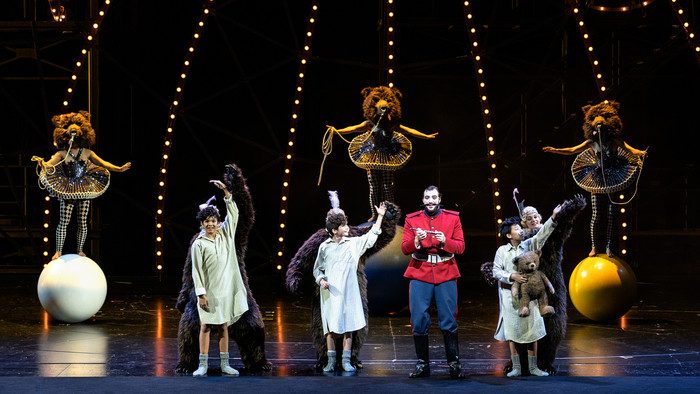Cast & Crew
Pamina – Christiane Karg
Queen of the Night – Albina Shagimuratova
Tamino – Mauro Peter
Papageno – Adam Plachetka
Sarastro – Matthias Goerne
Grandfather – Klaus Maria Brandauer
Director – Lydia Steier
Conductor – Constantinos Carydis
Description
Magic opera, Singspiel, a comedy with spectacular stage effects, Masonic ritual with Egyptian mysteries, heroic-comic opera? Die Zauberflöte is heard more often and has been more frequently performed, discussed, queried and interrogated than almost any other work in the history of opera. It is rare for the mysteriousness and multiformity of a work to be adjured with such mantric intensity. It is equally rare for a work to enjoy such undisputed success despite all these debates – and for over two hundred years at that.
Singspiels with a fairy-tale setting were in vogue on stages in the outlying districts of Vienna during the second half of the 18th century. Die Zauberflöte is part of this tradition: the high-spirited start to the action with the spectacular pursuit of prince by monster, a love story that begins with the quest of freeing an abducted princess and in which two antagonists in the shape of the Queen of the Night and Sarastro seem to fight for good and evil in the world, comical figures like Papageno, who blunders through all his trials like one of Rousseau’s natural men, thereby winning his place not only in the fabric of this opera but also in the hearts of the audience. And not least the magic flute itself, a magical instrument as ‘title character’, that together with the equally wondrous glockenspiel assumes the role of destiny. Emanuel Schikaneder, versatile artist and enterprising impresario, whose Theater auf der Wieden was known for its impressive special effects achieved by scene changes and the use of stage machinery, took one of his inspirations for the libretto from Christoph Martin Wieland’s Dschinnistan, a collection of fairy tales. Mozart’s work also reflects the contemporary fascination with ancient mysteries. Their initiation rites, in which trials and confrontation with death played an integral role, also inspired the Freemasons’ induction ceremonies, of which Mozart, himself a member of a Masonic lodge, had intimate knowledge.
It is difficult to decide whether the text follows a dramatic structure that is of only limited logic due to the amalgamation of heterogeneous sources of material, or if Mozart and Schikaneder created a unique and consistent dramatic composition precisely because of this fusion of fairy-tale elements, mystery play and Enlightenment thought. The perspective of this ambiguous opera changes depending on one’s point of view. For who in this work announces the ‘wise lessons’, which can be read equally as fairy-tale virtues or Masonic maxims? It is none other than the three mysterious ladies, who in the first act demand ‘courage and steadfastness’, ‘bravery’ and ‘love and bond of brotherhood’ from Tamino. Pamina and Papageno speak of ‘friendship’. Sarastro for his part demands the same – that is, not in any way new – notions for himself and his philosophy. Three boys, whose allegiance to the Queen of the Night or to Sarastro remains unclear, impart their youthful wisdom to Tamino on his path of trials. It is their advice that he desires to be ‘buried in his heart’ for ever. After their appearance Mozart rapidly expands the spectrum of keys in the finale of Act I – as if deliberately wanting to upset the innocent view of this fairy-tale world with its clear opposites of good and evil by contrasting it with a world of increasing complexity. Now all the figures are being tested, ultimately including the humanist ideals of the Enlightenment itself.
In Die Zauberflöte it is love that is victorious in the end –love and mystery. Its narrative power is located precisely in the exuberance and imagination with which both composer and librettist endowed their ‘deutsche Oper’. It is this superimposition of ostensibly fairy-tale elements over those supposedly enlightened by reason that keeps us in suspense – like the three boys, who as figures imbued with the ignorance of childhood yet – as in a fairy tale –possessed of knowledge guide the protagonists through their destinies. Setting the judgement of the heart against the dichotomy of good and evil, they provide yet another key to the solution of the mystery that is Die Zauberflöte.
In Die Zauberflöte it is love that is victorious in the end –love and mystery. Its narrative power is located precisely in the exuberance and imagination with which both composer and librettist endowed their ‘deutsche Oper’. It is this superimposition of ostensibly fairy-tale elements over those supposedly enlightened by reason that keeps us in suspense – like the three boys, who as figures imbued with the ignorance of childhood yet – as in a fairy tale –possessed of knowledge guide the protagonists through their destinies. Setting the judgement of the heart against the dichotomy of good and evil, they provide yet another key to the solution of the mystery that is Die Zauberflöte.
Screenings
- Arkhangelsk
- Astrakhan
- Chelyabinsk
- Chernogolovka
- Chita
- Fryazino
- Gelendzhik
- Irkutsk
- Ivanovo
- Izhevsk
- Kaliningrad
- Kazan
- Khabarovsk
- Krasnodar
- Krasnoyarsk
- Minsk
- Moscow
- Nizhny Novgorod
- Novokuznetsk
- Novosibirsk
- Obninsk
- Omsk
- Orekhovo-Zuyevo
- Penza
- Perm
- Petropavlovsk-Kamchatskiy
- Petrozavodsk
- Pskov
- Rostov-on-Don
- Ryazan
- Saint Petersburg
- Samara
- Saratov
- Sarov
- Sergiyev Posad
- Severodvinsk
- Sochi
- Tomsk
- Tyumen
- Ufa
- Ukhta
- Veliky Novgorod
- Volgograd
- Voronezh
- Yaroslavl
- Yekaterinburg
- Yuzhno-Sahalinks
Runtime
2 h. 40 min.
Language
Recorded screening: German, Italian, russian subtitles
12+
